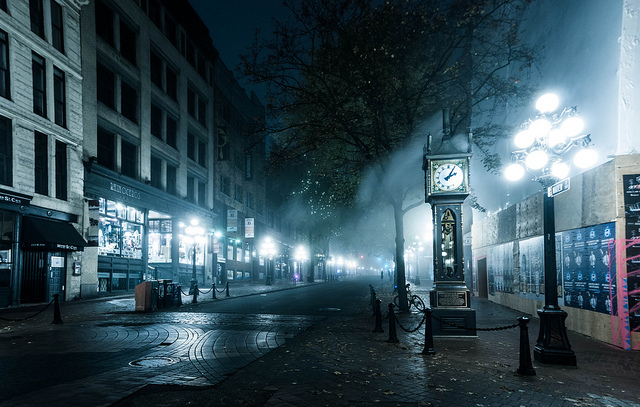
On the corner of Water and Cambie Streets, is a steam clock, one of only two in the world. Photo © Colink, licensed Creative Commons Attribution.
Just three blocks east of Canada Place, Gastown is a marvelous place to spend a few hours. It was the birthplace of Vancouver, officially named Granville in 1870 but always known as Gastown, for saloon owner “Gassy Jack” Deighton. …on the corner of Water and Cambie Streets, is a steam clock, one of only two in the world (the other is a replica of this, the original one).The Great Fire of 1886 destroyed almost all of Gastown’s wooden buildings, but the district was rebuilt in stone and brick. By 1900 the heart of the city had moved away from the waterfront, and as Gastown declined in importance it became rundown. By the 1960s this historical district held nothing more than decrepit Victorian-era buildings and empty warehouses. The government originally planned to redevelop the entire district, with intentions to construct an expressway through the heart of Gastown. The public outcry was loud and clear; Vancouverites were becoming more aware of their heritage. The plans were scuttled and Gastown was saved. A massive rejuvenation program commenced, and today historical Gastown is one of the city’s most popular tourist attractions. Tree-lined cobblestone streets and old gas lamps front brightly painted, restored buildings that hold galleries, restaurants, and an abundance of gift and souvenir shops.Most of the action centers along Water Street, which branches east off Cordova Street and slopes gently toward the site of Gassy Jack’s original saloon (now the Alhambra Hotel).
As you first enter Water Street, you’re greeted by The Landing, a seven-story heritage building that has had its exterior restored to its former glory and its interior transformed from a warehouse into an upmarket shopping arcade. It also holds several eateries and the Steamworks Brewing Co., a brew pub-restaurant boasting harbor views. Next door to The Landing is Hudson House, built in 1897 as a warehouse and retail outlet for the Hudson’s Bay Company.
Continuing down the hill, on the corner of Water and Cambie Streets, is a steam clock, one of only two in the world (the other is a replica of this, the original one). Built by a local clockmaker in the mid-1970s, it is powered by a steam system originally put in place to heat buildings along a 10-kilometer (6.2-mile) underground pipeline that snakes through downtown. Watch for the burst of steam every 15 minutes, which sets off steam whistles to the tune of Westminster chimes.
Continue east along Water Street to the 1899 Dominion Hotel, and then half a block south down Abbott Street to Blood Alley, the hangout of many infamous early-1900s rogues. Most buildings still standing along Water Street were built immediately after the Great Fire of 1886, but the Byrnes Block (2 Water St.) is generally regarded as the oldest; it stands on the site of Deighton House, Gassy Jack’s second and more permanent saloon. Behind this building is Gaolers Mews, the site of Vancouver’s first jail.
Water Street ends just around the corner at cobbled Maple Tree Square, the intersection of Water, Carrall, Powell, and Alexander Streets. Here you’ll find a bronze statue of Gassy Jack watching over the square and the site of his original saloon from the top of a whiskey barrel. The Alhambra Hotel, which occupies the actual saloon site, was built in 1886 from bricks used as ballast in ships that sailed into Burrard Inlet. Across from the statue is the Hotel Europe, a narrow triangular building. After its 1892 opening, the hotel quickly became recognized as the city’s finest hostelry.
Born in England in 1830, John Deighton took to the high seas at a young age in search of adventure and fortune. Partnering with an American businessman, he set up a crude saloon at New Westminster, quenching the thirst of Cariboo-bound prospectors and getting the nickname “Gassy,” which in British slang described an obnoxious drunk. Forced out of New Westminster by his business partner, he set off to make his fortune elsewhere. On July 4, 1867, with just his native wife and a barrel of whiskey, Gassy Jack beached his small boat on the shore of Burrard Inlet below the sawmill owned by Captain Edward Stamp. Because Stamp had banned alcohol from his company town, Gassy Jack found an eager market for his liquor. The next morning, enlisting the help of locals, he erected a ramshackle saloon. With a rousing speech to the workers, he declared free drinks for everyone for the rest of the day and was on his way to making a small fortune.
The Globe Saloon, as Deighton’s enterprise became known, was soon a social center, and more buildings sprang up around his business. Three years after serving his first tot of whiskey, Gassy Jack became the first official landowner in Granville when he purchased Lot 1 of the newly laid out settlement. With tax collectors on his tail, he was forced to move his operation into a more permanent building, so he opened a hotel on his lot, providing both liquor and accommodations.
Life as a saloon owner took its toll on the entrepreneur. Wild drunken brawls brought unwanted attention from local police officers; he was continually hounded by tax collectors; and his wife died at a young age. Gassy died in a summer heat wave at just 45 years old. His funeral cost an unheard-of sum of $136.
Excerpted from the Sixth Edition of Moon Vancouver & Victoria.